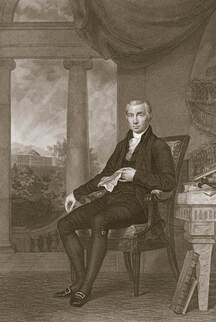 On June 1, 1819, the city of Huntsville was surprised by an unannounced visit by Pres. James Monroe, whose signature would admit the state of Alabama to the Union later in the year. (Library of Congress)
On June 1, 1819, the city of Huntsville was surprised by an unannounced visit by Pres. James Monroe, whose signature would admit the state of Alabama to the Union later in the year. (Library of Congress) After leading lights paid their respects to the nation’s leader in a series of toasts given over a sumptuous meal, Monroe offered one of his own for the Alabama Territory that struck at the heart of what lay on everyone’s minds: “May her speedy admission into the Union advance her happiness, and augment the national strength and prosperity.”
Virtually as soon as the gavel closing the proceedings fell, campaigning for seats in the first session of the General Assembly of the State of Alabama, called for October, began. In late September 1819, twenty-two senators and fifty representatives won election to the state’s new legislature, as well as a number of other state officials as specified in the constitution. Though the race for the state’s chief executive ended up being tighter than might have been expected, owing to the rising discontent with the “Georgia Faction” in Alabama’s affairs, territorial governor William Wyatt Bibb secured the honor of also heading Alabama’s first state government. As the mild days of early fall replaced the sultry days of summer, he busied himself preparing an address to the legislature which he hoped would set the agenda for the new state’s lawmakers. Once again Alabama’s preeminent city of Huntsville would serve as the backdrop to another landmark gathering.
 RSS Feed
RSS Feed